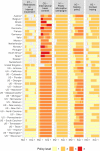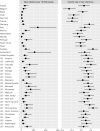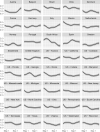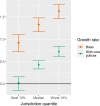Which COVID policies are most effective? A Bayesian analysis of COVID-19 by jurisdiction
- PMID: 33373384
- PMCID: PMC7771876
- DOI: 10.1371/journal.pone.0244177
Which COVID policies are most effective? A Bayesian analysis of COVID-19 by jurisdiction
Abstract
This paper reports the results of a Bayesian analysis on large-scale empirical data to assess the effectiveness of eleven types of COVID-control policies that have been implemented at various levels of intensity in 40 countries and U.S. states since the onset of the pandemic. The analysis estimates the marginal impact of each type and level of policy as implemented in concert with other policies. The purpose is to provide policymakers and the general public with an estimate of the relative effectiveness of various COVID-control strategies. We find that a set of widely implemented core policies reduces the spread of virus but not by enough to contain the pandemic except in a few highly compliant jurisdictions. The core policies include the cancellation of public events, restriction of gatherings to fewer than 100 people, recommendation to stay at home, recommended restrictions on internal movement, implementation of a partial international travel ban, and coordination of information campaigns. For the median jurisdiction, these policies reduce growth rate in new infections from an estimated 270% per week to approximately 49% per week, but this impact is insufficient to prevent eventual transmission throughout the population because containment occurs only when a jurisdiction reduces growth in COVID infection to below zero. Most jurisdictions must also implement additional policies, each of which has the potential to reduce weekly COVID growth rate by 10 percentage points or more. The slate of these additional high-impact policies includes targeted or full workplace closings for all but essential workers, stay-at-home requirements, and targeted school closures.
Conflict of interest statement
The authors have declared that no competing interests exist.
Figures






References
MeSH terms
LinkOut - more resources
Full Text Sources
Medical

